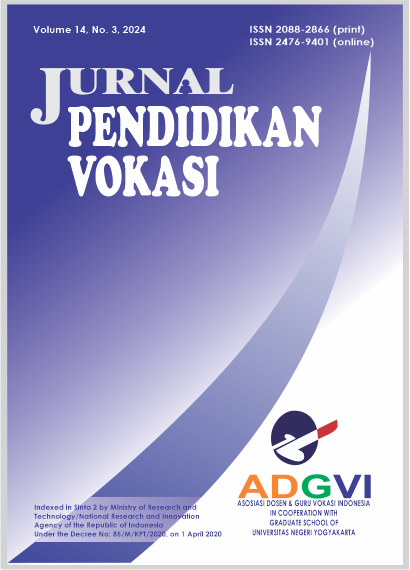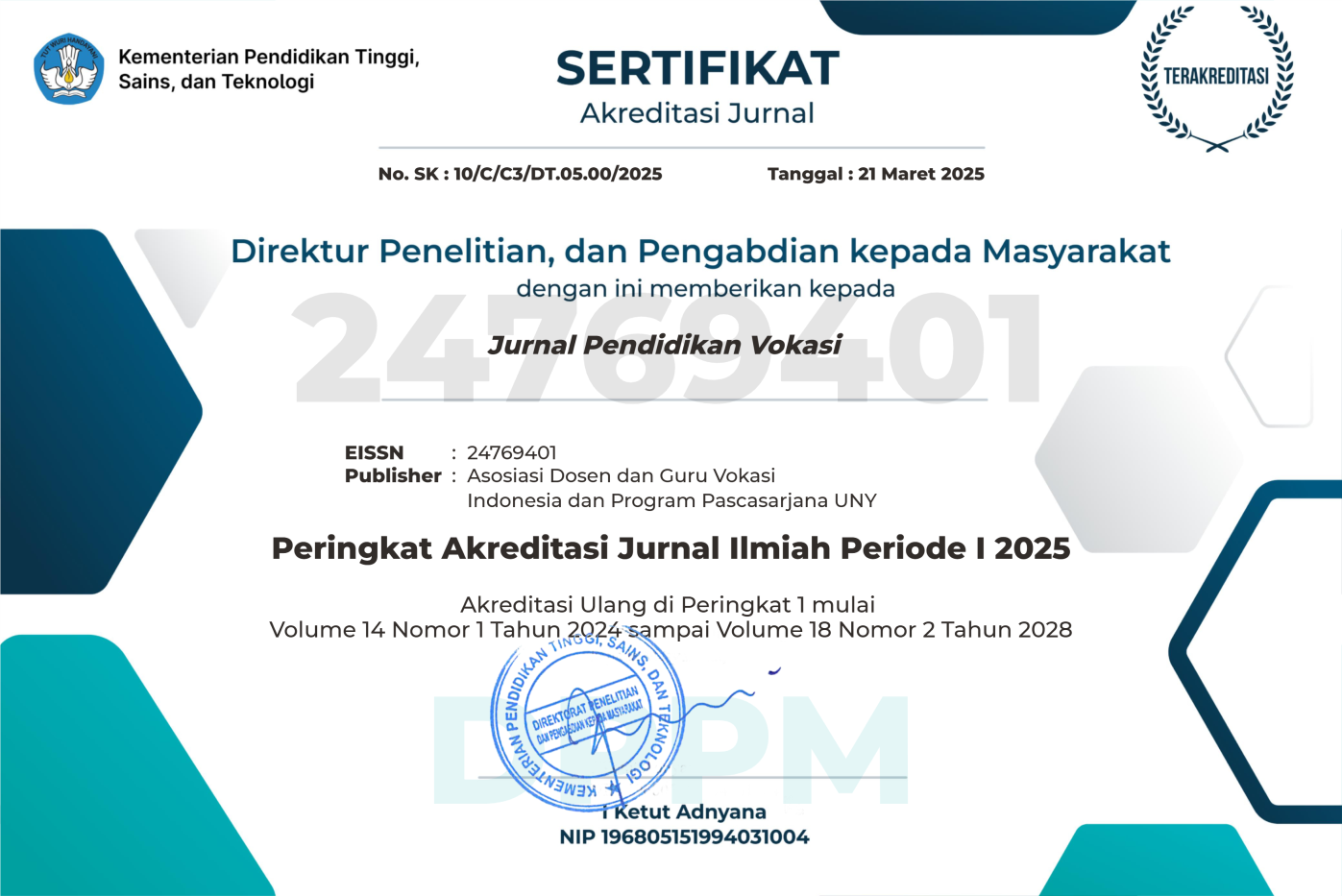Developing integrated control systems media to enhance the electrification competency of electric railway drives
DOI:
https://doi.org/10.21831/jpv.v14i3.77344Keywords:
Electrification competency, Electric railway drives, Integrated control systems, Instructional media, Traction system, Vocational educationAbstract
This study aimed to develop and evaluate integrated control systems media for the traction system of electric railway drives to enhance students’ electrification competencies. Specifically, the study sought to analyze the operation, assess the feasibility, and produce effective instructional media for use in the Railway Electrical Engineering program at Madiun State Polytechnic. A development research design was employed by combining the RAD (Rapid Application Development) and ASSURE models. The subjects were 39 railway students, and data were collected through observations, interviews, questionnaires, and tests. Instrument validation was conducted using Aiken’s V and Pearson Product Moment correlation, while reliability was tested with Cronbach’s Alpha. Data were analyzed using Huberman’s steps for qualitative findings and descriptive statistics, Wilcoxon test, and Gain Score analysis for quantitative data. The results indicate that the developed traction system media—consisting of an application and teaching modules—were rated “Very Feasible” by experts and students. Statistical tests showed significant improvements in the electrification competencies of the experimental group compared to the control group. The integrated control systems media not only support effective laboratory practice but also foster interactive and engaging learning experiences. This study contributes to vocational education by demonstrating how technology-based instructional media can strengthen students’ technical competencies in railway electrification and by providing a model that can be replicated in other polytechnic and technical training contexts.
References
Abror, A. F., & Jati, H. (2016). pengembangan dan analisis kualitas aplikasi penilaian e-learning SMK berbasis ISO 19796-1 di Yogyakarta. Jurnal Pendidikan Vokasi, 6(1), 1. https://doi.org/10.21831/jpv.v6i1.7623
Arsyad, A. (2009). Media pembelajaran (A. Rahman (ed.)). Raja Grafindo Persada.
Benoliel, M. A., Ferreira, P., & Silva, C. M. (2023). Green urban railway stations: A methodology to assess and improve sustainability. Transportation Research Procedia, 72, 1515–1522. https://doi.org/10.1016/j.trpro.2023.11.618
Bhattacharyya, A., & Kumar, N. (2020). Who is more entrepreneurial? A comparative study of vocational and academic students. Asia Pacific Journal of Innovation and Entrepreneurship, 14(1), 15–30. https://doi.org/10.1108/APJIE-06-2019-0047
Branch, R. M. (2009). Instructional design: The ADDIE approach. Springer US. https://doi.org/10.1007/978-0-387-09506-6
Chen, L., & Ifenthaler, D. (2021). Mobile learning and social media applied in entrepreneurship education courses in a higher vocational college. 2021 IEEE International Conference on Engineering, Technology & Education (TALE), 1023–1027. https://doi.org/10.1109/TALE52509.2021.9678928
Chirkov, V. (2023). Alfred Schutz’s ‘Stranger’, the theory of sociocultural models, and mechanisms of acculturation. Culture & Psychology, 29(1), 116–138. https://doi.org/10.1177/1354067X221103991
Chymera, M., & Goodman, C. J. (2014). The calculation of train performance. IET 13th Professional Development Course on Electric Traction Systems. https://doi.org/10.1049/cp.2014.1431
Daryanto, D. (2013). Menyusun modul bahan ajar untuk persiapan guru dalam mengajar. Gava Media.
Fahmy, S., Haslinda, N., Roslina, W., & Fariha, Z. (2012). Evaluating the quality of software in e-book using the ISO 9126 model. International Journal of Control and Automation, 5(2), 115–122. https://www.researchgate.net/profile/Syahrul-Fahmy/publication/266507818_Evaluating_the_Quality_of_Software_in_e-Book_Using_the_ISO_9126_Model/links/5639948d08aed5314d222446/Evaluating-the-Quality-of-Software-in-e-Book-Using-the-ISO-9126-Model.pdf
Fatoni, M. S. M., & Handoko, Y. A. (2024). Efisiensi energi pada perkeretaapian listrik perkotaan. Jurnal Perkeretaapian Indonesia (Indonesian Railway Journal), 8(1), 8–20. https://doi.org/10.37367/jpi.v8i1.296
Foster, B. S., & Ramelan, K. R. (2001). Pembinaan untuk meningkatkan kinerja karyawan. PPM.
Handoko, H., Kuswati, A. S., Imron, N. A., & Prasetiyo, A. yuda. (2024). The influence of EMU driver education and training on train driver competency Indonesian high speed rail “Whoosh.” Journal of Railway Transportation and Technology, 3(1), 35–39. https://doi.org/10.37367/jrtt.v3i1.36
Harahap, E. F., Adisuwiryo, S., & Fitriana, R. (2022). Analisis dan perancangan sistem informasi. Wawasan Ilmu.
Jumadin, J., Anandari, D. R., & Dewi, S. S. (2020). Kualitas pembelajaran mahasiswa vokasi Fakultas Teknik Universitas Negeri Makassar. Jurnal Media Elektrik, 17(3), 106–111. https://doi.org/10.59562/metrik.v17i3.5403
Kamiya, Y., Miyazaki, M., & Tanaka, Y. (2024). Expectations and possibilities of using IoT in education. 2024 12th International Conference on Information and Education Technology (ICIET), 353–357. https://doi.org/10.1109/ICIET60671.2024.10542719
Kosasih, U. K., Saputra, S., & Supriadi, E. A. (2022). Pengembangan bahan ajar bentuk aljabar melalui pendekatan open-ended. PERISAI: Jurnal Pendidikan Dan Riset Ilmu Sains, 1(1), 90–97. https://doi.org/10.32672/perisai.v1i1.64
Krismadinata, Kurnia, U. I., Mulya, R., & Verawardina, U. (2022). The interactive multimedia learning for power electronics course. International Journal of Online and Biomedical Engineering (IJOE), 18(7), 44–56. https://doi.org/10.3991/ijoe.v18i07.30029
Lasmiyati, L., & Harta, I. (2014). Pengembangan modul pembelajaran untuk meningkatkan pemahaman konsep dan minat SMP. PYTHAGORAS Jurnal Pendidikan Matematika, 9(2), 161–174. https://doi.org/10.21831/pg.v9i2.9077
Lin, X., & Yang, J. (2019). Supporting green transportation with transport impact assessment: Its deficiency in Chinese cities. Transportation Research Part D: Transport and Environment, 73, 67–75. https://doi.org/10.1016/j.trd.2019.06.004
Lisdiantini, N., Azis, A., Syafitri, E. M., & Thousani, H. F. (2022). Analisis efektifitas program magang untuk sinkronisasi link and match perguruan tinggi dengan dunia industri (studi terhadap program magang mahasiswa Program Studi Administrasi Bisnis Politeknik Negeri Madiun). ECOBISMA (JURNAL EKONOMI, BISNIS DAN MANAJEMEN), 9(2), 22–31. https://doi.org/10.36987/ecobi.v9i2.2491
Ma, C., & Lautala, P. T. (2011). Railway education today and steps toward global education. 2011 Joint Rail Conference, 531–540. https://doi.org/10.1115/JRC2011-56109
Mubarak, S., Ansharullah, A., & Dewi, H. I. (2021). Pengembangan modul pembelajaran tematik melalui problem based learning. Instruksional, 3(1), 57. https://doi.org/10.24853/instruksional.3.1.57-65
Mufidah, C. I. (2018). Pengembangan modul pembelajaran pada kompetensi dasar hubungan masyarakat Kelas X APK 2 di SMKN 10 Surabaya. Jurnal Pendidikan Administrasi Perkantoran (JPAP), 6(1). https://ejournal.unesa.ac.id/index.php/jpap/article/view/9487/9381
Nasri, M. H., Hartanto, R., Permanasari, A. E., & Arfian, N. (2020). The user experience effect of applying Floating Action Button (FAB) into augmented reality anatomy cranium media learning prototype. 2020 3rd International Seminar on Research of Information Technology and Intelligent Systems (ISRITI), 354–359. https://doi.org/10.1109/ISRITI51436.2020.9315459
Prihatiningtyas, S., Yunus, S. R., & Shofiyah, N. (2023). Media instrumen e-tes berbasis web sebagai alternatif penilaian yang efektif dalam proses pembelajaran. Jurnal IPA Terpadu, 7(2), 221. https://doi.org/10.35580/ipaterpadu.v7i2.48381
Purwono, A., Muhardono, M., & Ryanto, A. H. (2018). Analysis of monthly maintenance performance (P1, P3, P6) commuter line Dipo Depok. Jurnal Perkeretaapian Indonesia (Indonesian Railway Journal), 3(1). https://doi.org/10.37367/jpi.v3i1.73
Rehman, F. U., Islam, M. M., & Miao, Q. (2023). Environmental sustainability via green transportation: A case of the top 10 energy transition nations. Transport Policy, 137, 32–44. https://doi.org/10.1016/j.tranpol.2023.04.013
Salehi, M., Jalalian, M., & Siar, M. M. V. (2017). Green transportation scheduling with speed control: trade-off between total transportation cost and carbon emission. Computers & Industrial Engineering, 113, 392–404. https://doi.org/10.1016/j.cie.2017.09.020
Sangsawang, T. (2015). Instructional design framework for educational media. Procedia - Social and Behavioral Sciences, 176, 65–80. https://doi.org/10.1016/j.sbspro.2015.01.445
Sarjana, S. (2023). Green transportation: Development opportunities in support of sustainable transportation. E3S Web of Conferences, 429, 03003. https://doi.org/10.1051/e3sconf/202342903003
Sirate, S. F., & Ramadhana, R. (2017). Pengembangan modul pembelajaran berbasis keterampilan literasi. Inspiratif Pendidikan, 6(2), 316. https://doi.org/10.24252/ip.v6i2.5763
Sudira, P. (2017). TVET Abad XXI: Filosofi, teori, konsep, dan strategi pembelajaran vokasional (H. Hartono (ed.); 2nd ed.). UNY Press.
Sudira, P. (2018). Metodologi pembelajaran vokasional abad XXI: Inovasi, teori, dan praksis (B. Lastariwati (ed.)). UNY Press.
Sumaryoto, D. R. I., & Handoko, Y. A. (2024). Artificial intelligence in regenerative braking for trains: A systematic review. Jurnal Perkeretaapian Indonesia (Indonesian Railway Journal), 8(1), 21–31. https://doi.org/10.37367/jpi.v8i1.298
Wang, B., Huang, T., Zhou, L., Guan, L., & Wan, K. (2024). Integration of EMU overall design model based on ontology–knowledge collaboration. Applied Sciences, 14(17), 7828. https://doi.org/10.3390/app14177828
Widodo, I. K. (2017). Pengembangan media pembelajaran website berbasis Responsive Web Design (RWD) mata pelajaran ekonomi untuk materi pasar modal kelas XI Sekolah Menengah Atas (SMA) [Universitas Negeri Yogyakarta]. https://eprints.uny.ac.id/52999/1/Skripsi 12804241010.pdf
Published
How to Cite
Issue
Section
Citation Check
License
Copyright (c) 2025 Jurnal Pendidikan Vokasi

This work is licensed under a Creative Commons Attribution-ShareAlike 4.0 International License.
The authors submitting a manuscript to this journal agree that, if accepted for publication, copyright publishing of the submission shall be assigned to Jurnal Pendidikan Vokasi. However, even though the journal asks for a copyright transfer, the authors retain (or are granted back) significant scholarly rights.
The copyright transfer agreement form can be downloaded here: [JPV Copyright Transfer Agreement Form]
The copyright form should be signed originally and sent to the Editorial Office through email to jpvokasi@uny.ac.id
Jurnal Pendidikan Vokasi by http://journal.uny.ac.id/index.php/jpv is licensed under a Creative Commons Attribution-ShareAlike 4.0 International License.













